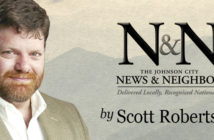By Jeff Keeling
 After climbing past masses of blooming trout lilies, their delicate yellow blooms nodding toward the damp earth, I reached one of many prized experiences at Jacob’s Nature Park at Sinking Creek. The loop trail took the last rise on its east end, and what I call the silver sisters – two big old beech trees – towered like lofty sentinels on either side of the path.
After climbing past masses of blooming trout lilies, their delicate yellow blooms nodding toward the damp earth, I reached one of many prized experiences at Jacob’s Nature Park at Sinking Creek. The loop trail took the last rise on its east end, and what I call the silver sisters – two big old beech trees – towered like lofty sentinels on either side of the path.
To reach the ridgetop, I had had to cross Sinking Creek on a couple of logs, aided only by a rope strung across the span. By the time the trout lilies usher in spring in 2017, though, reaching the environmental park’s wooded ridge should be a much easier proposition.
After years of perseverance by local attorney Bill Francisco and a growing, dedicated band of allies, the 28 acres of wetland and woodland across from Rich Acres Baptist Church on King Springs Road is on the cusp of getting some crucial infrastructure. Materials are on order for a handicapped-accessible bridge that will link the parks two sections.
A new sign that includes a silhouette of the park’s namesake, the late Jacob Francisco, will be installed at the entrance soon. The excellent interpretive sign now at the entrance will be relocated to an area bordering one of the wetlands, where an outdoor classroom also could be completed before year’s end.
Francisco discovered what has become the city’s newest park about a half-decade ago. After 6-year-old Jacob’s 2004 death from an e coli infection, Francisco began raising funds annually in his memory, centered around water contamination issues.
Those monies funded professional lectures for several years, and then Francisco got involved with Boone Watershed Partnership (BWP). A project to improve water quality along Sinking Creek included mitigation of the wetlands in what is now the park, and Francisco transitioned his annual efforts to that location. Those wetlands are beautiful, verdant and critical to Sinking Creek’s future, as they help filter pollutants in the stream whose waters remain unsafe due to pollution.
As Francisco, BWP colleagues, Boy Scouts, college students and Johnson City Parks and Recreation – among others – have labored to cut trails and ready the park for more substantial infrastructure, the park has become a source of enjoyment and education to a growing number of people. Parks and Rec naturalist Connie Deegan uses it as a site for outdoor teaching. ETSU students and professors study its waters and wildlife.
For this city treasure to become fully accessible and reach its highest potential – its west, or upstream end is a short walk from the Tweetsie Trail, promising the likelihood of significant visitation – it needs even more infrastructure. In specific, as shown on an early site plan, its several acres of wetlands could be enjoyed by many with the construction of a few hundred yards of boardwalk.
It’s my understanding the Parks and Recreation Board may ask the City Commission to consider a fiscal 2017 financial investment to accelerate what will be, in relative terms, an affordable, high-return build out of the park. I’ve traveled the park with a number of children over the past couple years. I can’t think of one who didn’t love it.
Bill Francisco is one of my heroes. He deserves a medal for his tireless efforts to help make this 28-acre piece of paradise an asset that will serve citizens well for decades to come. It’s been encouraging to see a growing cadre of people, organizations and businesses who recognize the park’s fantastic potential come alongside and work with him. The city and parks and rec have helped, too. This year, I hope commissioners consider doing what it takes – $100,000 would go a long way – to put the project over the top.




